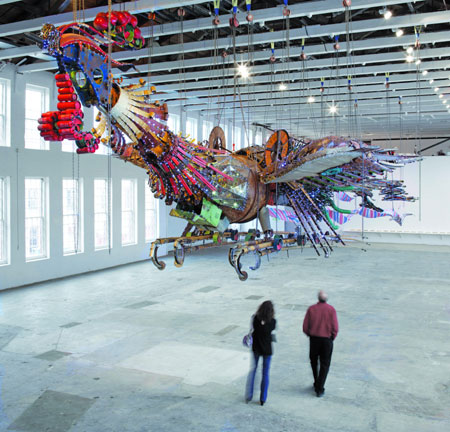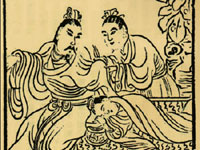
 'Taken 2' grabs movie box office crown
'Taken 2' grabs movie box office crown
 Rihanna's 'Diamonds' tops UK pop chart
Rihanna's 'Diamonds' tops UK pop chart
 Fans get look at vintage Rolling Stones
Fans get look at vintage Rolling Stones
 Celebrities attend Power of Women event
Celebrities attend Power of Women event
 Ang Lee breaks 'every rule' to make unlikely new Life of Pi film
Ang Lee breaks 'every rule' to make unlikely new Life of Pi film
 Rihanna almost thrown out of nightclub
Rihanna almost thrown out of nightclub
 'Dark Knight' wins weekend box office
'Dark Knight' wins weekend box office
 'Total Recall' stars gather in Beverly Hills
'Total Recall' stars gather in Beverly Hills
Wings of aspiration
Updated: 2013-01-07 10:15
By Kelly Chung Dawson (China Daily)
|
||||||||
 |
|
Visitors to the Massachusetts Museum of Contemporary Art approach one of two giant phoenix installations that artist Xu Bing created from construction waste. [Provided to China Daily] |
Artist Xu Bing's massive phoenixes take flight in the US, giving exhibition-goers a complex sense of China's rise. Kelly Chung Dawson reports in New York.
The phoenix has appeared in both Western and Eastern mythologies for millennia, with variations in form and symbolism across cultures.
The healing birdlike simurgh of Persian folklore was said to have survived human civilization's destruction and rebirth three times.
In China, the ancient fenghuang was originally two birds, male and female, that along with the dragon, tortoise and chimerical qilin, governed the universe. Its appearance traditionally heralds an era of peace and prosperity. Unlike its Western counterpart, said to cycle through death and rebirth, the fenghuang lives forever.
In a new installation at the Massachusetts Museum of Contemporary Art, the artist Xu Bing recently unveiled two Chinese phoenixes, each weighing 1.8 tons. The work explores the meaning, to various audiences, of China's rise.
The birds, 27 and 30 meters long, are suspended from the ceiling of a football-field-sized wing of the museum, and are assembled entirely from the detritus of urban Chinese construction sites collected over two years. At night, LED lights shine from within the sculptures like pinpoints of a constellation.
"In Chinese culture, the phoenix symbolizes the hopes and desires of a better future, even when those hopes are not necessarily realizable," the artist says.
Xu, vice-president of Beijing's Central Academy of Fine Arts, is known worldwide for his subversive calligraphic explorations of Chinese language.
His 1988 installation Book from the Sky featured thousands of mock Chinese characters that appeared authentic at first glance. In 1999, Xu was awarded a prestigious MacArthur Foundation "genius" fellowship in crafts and design.
"He is a consummate interpreter and interpolator of different traditions, cultures and languages," Mass MoCA director Joseph Thompson says.
"In the West, the phoenix signifies rising from the ashes of destruction, and that mythology doesn't exist in China. He is clever in encouraging us to merge those meanings. I admire the way he continuously prods us, making us realize that just when we think we understand a culture, we don't.
"Likewise, when we think interpretation or understanding is impossible, he proves that it's more direct than we think," Thompson says.
The phoenix project began in 2007 as a commissioned work to be installed between two new skyscrapers in Beijing's central business district. When Xu arrived at the site, he was struck by the lives of construction workers.
"There was an intense contrast between their conditions and the beautiful and modern buildings being built everywhere around us," Xu recalls. "I felt that so many of these big luxurious buildings being built in China are made to show off wealth, and I started thinking about the possibility of using trash, tools and the things these workers used in daily life to make something.
"Putting this really raw material inside a luxurious building would make it appear more luxurious, and would also emphasize the rawness of the conditions of the workers. I realized it was a way to talk about the relationship between wealth and labor in China."
The installation, Phoenix, was to appear in a glass atrium, which to Xu's eyes looked a bit like a cage, he says. He decided to make a pair of birds in flight, moving upward as if unaware of their constraints.
"I wanted to create both a sense of limitation, and also a complete lack of limitations," the artist says. "There is a tension there."
While the birds might be read as critical of economic development, they aren't meant to convey a message that simple, Thompson says.

|

|
Most Viewed
Editor's Picks

|

|

|

|

|

|
Today's Top News
Boston bombing suspect reported cornered on boat
7.0-magnitude quake hits Sichuan
Cross-talk artist helps to spread the word
'Green' awareness levels drop in Beijing
Palace Museum spruces up
First couple on Time's list of most influential
H7N9 flu transmission studied
Trading channels 'need to broaden'
US Weekly

|

|








